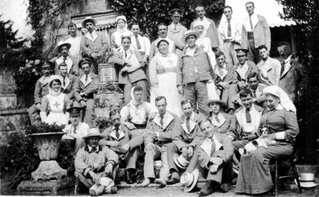The man on the right is Jack Chatfield, an officer's steward who served aboard HMS Cochrane and later HMS Amphitrite during WW1 before being invalided out of the service in 1919. Jack was one of four Chailey brothers who served his country during WW1, all four of them surviving.
This is Jack's story:
Jack Chatfield was born on 16th July
1896. His surviving Naval papers give
his place of birth as Lewes although the 1901 census states Newick. When the census was taken he was living at
The Rough, Newick with his family. The
household comprised Alfred Chatfield (aged 42, head of the family, born at
Fletching and working as a domestic gardener), his wife Mary Chatfield (aged
42, born in Newick) and their six children: Mabel Chatfield (aged 14, born
Fletching), Emily Chatfield (aged 13, born Fletching), Harry Chatfield (aged
ten, born Uckfield), Frank Chatfield (aged eight, born Fletching), Jack (aged
four, recorded as John) and Thomas Chatfield (aged two, born Newick).
There were other children as well. The 1891 census shows the family living at Church Street
Jack joined the Royal Navy at Portsmouth Portsmouth
In July 1916, the parish magazine
reported that Jack had joined HMS Argonaut although there is no
mention of this on his naval papers. HMS
Argonaut (a 16 gun cruiser belonging to the Diadem class and launched at
Govan in 1898) eventually became a training ship for stokers and was based at
Portsmouth and I think it likely that he spent some time on this ship although
his record simply states HMS Victory I (Portsmouth)
Between 14th October 1916 and 25th
November 1917 Jack Chatfield was serving aboard HMS Cochrane. This was a large armoured cruiser of the
Warrior Class. The ship was built at
Govan by Fairfield Jutland . In 1917 she was
stationed in North America and the West Indies and then to Archangel
in May 1918 until September the same year. On her return she ran aground in the
Mersey on the 14th November 1918 and was a
total loss. She was finally demolished by June 1919.
In November 1917, Jack spent a further
five months at Portsmouth (HMS Victory I) and then, between 9th
April 1918 and 31st March 1919, served aboard HMS Amphitrite. He
was finally invalided out of the Royal Navy on 1st April 1919.
Throughout his war service his character
was noted as “very good”, with his ability ranging from “moderate” to
“satisfactory”.
Jack Chatfield joined the Royal Navy on
the same day as Alfred Beard. Presumably the two men were friends and
decided to enlist together. Six digits
separate their service numbers.
Three of Jack’s brothers – Frank Chatfield, Harry Chatfield and Thomas Chatfield - also
served their King and Country during the First World War.
I am grateful to David Gordon for sending me this photograph of his relative which I am delighted to add to the growing gallery of Chailey's First World War servicemen and women.









